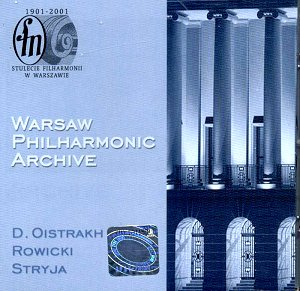This forms part of
a series derived from performances given
by the Warsaw Philharmonic and released
from their archive under the aegis of
CD Accord. Most of the batch I shall
be reviewing date from the 1960s though
there are earlier performances such
as a 1954 Rowicki-led Coriolan. Focus
here turns to David Oistrakh and two
staples of his repertoire of which the
Szymanowski No. 1 will probably prove
the more intriguing repertoire to those
who have yet to make the acquaintance
of Oistrakh’s 1959 recording of the
work with Kurt Sanderling and the Leningrad
State Philharmonic.
In the Szymanowski,
Oistrakh was partnered not by Rowicki
– who went on to record both concertos
with Wanda Wilkomirska – but by Karol
Stryja. The conductor had studied with
Fitelberg, a great champion of Polish
music in general and Szymanowski and
Karłowicz
in particular. He was associated with
the Silesian Philharmonic for a remarkable
length of time – just under forty years
– and toured with them, as well as taking
appointments abroad (in Denmark for
example with the Odense Orchestra).
He died in Katowice in 1998.
He proves an idiomatic foil for Oistrakh
and secures good playing from the Warsaw
forces. The violinist was one of the
few international virtuosi seriously
committed to the work at the time –
others tended to give single performances
and drop it from their repertoire –
and he brings his big tone and colossal
vibrancy to bear on it. Not only that
of course. His exceptional ability to
think in narrative terms works abundantly
to the work’s advantage, and his passionate
generosity grants sweeping advocacy
for the concerto. Stryja marshals his
winds to fine effect and though the
recording somewhat constricts the full
dynamic range of the performance it
emerges as something of a major Oistrakh
statement. Those for whom Oistrakh is,
however, too eloquently and opulently
expressive should listen to Eugenia
Uminska’s 1948 recording with the Philharmonia
conducted by Stryja’s teacher, the legendary
Fitelberg. Her austerity, tonal and
expressive, and Fitelberg’s amazingly
animated sense of design and colour
are must-haves in this repertoire.
His Brahms is a known
quantity from the famous quartet of
commercial recordings with Gauk, Abendroth,
Ehrling and Cluytens. In October 1969
with Rowicki conducting Oistrakh takes
a little time to warm up but once his
intonation has centred he gives plenty
of opportunities to admire his superbly
colouristic vibrato, the quick – and
very infrequent – portamenti and the
constant inflexions of light and shade
that illuminate his musical argument.
Oistrakh really was a master of the
long paragraph and one can hear it throughout
this disc. Occasionally one feels Rowicki’s
less than seamless handling of the orchestra
in the first movement (some passages
seem rather imposed). Oistrakh illustrates
all his characteristic tonal nuance
in the slow movement – where the imprecision
of the wind chording is only a temporary
distraction – and he is genial and warm-hearted
in the finale where he intensifies his
vibrato nicely. He’s certainly more
avuncular here than the motoric Heifetz
and Adolf Busch in their performances
and he’s similarly less intense than
many of his competitors in the opening
movement – his Soviet rival Kogan being
an obvious example.
As adjuncts to his
central discography these performances
are highly attractive for Oistrakh admirers.
The notes are in Polish and English
and relate to the Warsaw Philharmonic
and the performers but not the particular
circumstances of the performances. Incidentally
I’m sure that the strange and very occasional
squeaking noise in the Brahms is not
a degraded tape so much as the noisy
shoes of Rowicki – or was it Oistrakh?
Jonathan Woolf
The
entire CDAccord catalogue is available
from MusicWeb
 Buy
through MusicWeb for
£10.50 postage paid
World-wide.
Immediate delivery
Buy
through MusicWeb for
£10.50 postage paid
World-wide.
Immediate delivery ![]() for
details
for
details